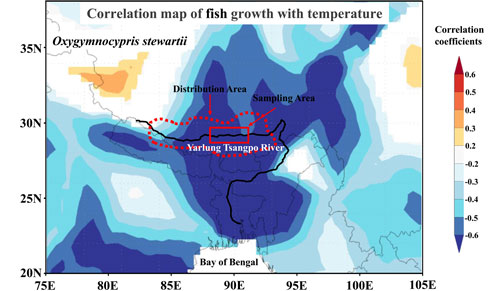
Newsroom
Chinese Scientists Reveal Response of Riverine Fish to Recent Climate Change
Climate change and its environmental consequences have been widely observed and acknowledged. Understanding how sensitive ecosystems respond to climate change is essential for effective conservation and management, and can provide sentinels for changes in other ecosystems. The Tibetan Plateau (TP) is one of the most globally sensitive areas to climate change with potentially serious implications for resident fish populations and aquatic food webs. The Yarlung Tsangpo River is the world’s highest elevation large river and one of the most climate-change sensitive catchments on the TP. Warming can stimulate increases in primary production (including the growth of benthic algae and phytoplankton) in lakes and rivers. At present, it is largely unknown how climate-induced changes in aquatic primary production and terrestrial carbon subsidies to aquatic food webs will affect fish growth in the TP.
The Research Group of Biological Invasion and Adaptive Evolution (BIAE; PI: Yifeng Chen) at Institute of Hydrobiology (IHB) of Chinese Academy of Sciences recently investigated the climate change response of two endemic fish species (e.g., the omnivorous Schizopygopsis younghusbandi and the carnivorous Oxygymnocypris stewartii) in the Yarlung Tsangpo River, using growth index chronologies derived from fish otoliths.
The results revealed that the growth of two riverine fishes occupying different trophic levels from the Yarlung Tsangpo River was sensitive to climate and displayed high synchrony with each other. In this glacial-fed river, the growth of both fish species was significantly and negatively correlated with the mean annual air temperature, while it was positively but not significantly correlated with precipitation and discharge.
The higher trophic level species O. stewartii was more sensitive to climate than was the lower trophic level species S. younghusbandi, with temperature variables explaining a higher proportion of growth variability in O. stewartii (64.6%) than in S. younghusbandi (46.4%). The results collectively indicate that both species are highly sensitive to climate change, which may affect fish growth by altering water environment, fish physiological fitness and food availability.
This study provides further empirical evidence of the utility of growth-increment chronologies for investigating the effects of climate change on aquatic ecosystems across different basins and water body types of the TP. These findings can inform conservation and management actions related to addressing climate change on the TP and other high-elevation temperate systems found worldwide.
This work has been published in the journal Science of the Total Environment. The project was supported by the Strategic Lead Research Program of the Chinese Academy of Sciences (Grant nos. XDA20050204 and XDB31000000), the National Natural Science Foundation of China (Grant nos. 31372189 and 41030208), National Basic Research Program of China (Grant no. 2014FY210700) and the Knowledge Innovation Project of the Chinese Academy of Sciences (Grant no. KSCX2-YW-Z-1023).

Correlation map of fish growth with temperature (Image by IHB)
(By SUI Xiaoyun; Editor: MA Yun)